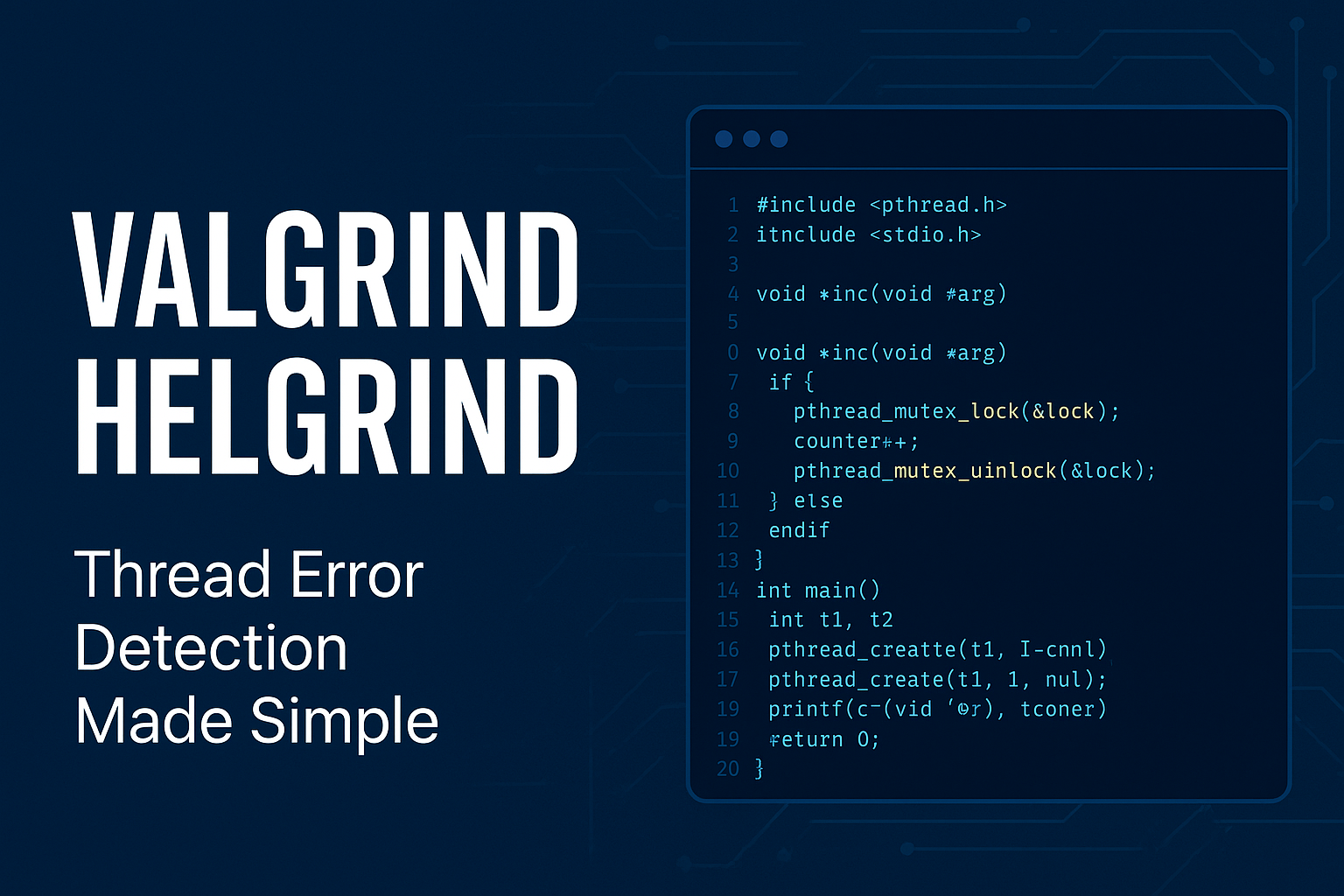Valgrind 并发调试 ·:用 Helgrind 抓住线程里的“看不见的错”
📖 针对Valgrind 并发调试 :同步B站的视频课程讲解
Valgrind 并发调试 ·:用 Helgrind 抓住线程里的“看不见的错”
目标:用最小示例快速理解 Valgrind Helgrind 的作用与价值,掌握一套可复用的检查流程。下一篇会单讲 DRD 并与 Helgrind 做更系统对比。

1. Helgrind 是什么?
Helgrind 是 Valgrind 的线程错误检测器,专注发现:
- 数据竞争(Data Race):多线程对同一内存的未同步读/写、写/写。
- 锁使用错误:忘记解锁、重复加锁、加锁顺序反转、潜在死锁提示等。
- 条件变量/线程 API 误用:如
pthread_cond_wait()未持锁、线程退出仍持锁等。
一句话:普通运行“看起来没事”的并发 bug,Helgrind 能第一时间指出来。
2. 最小可复现示例(Data Race)
下面这段代码存在竞态:两线程未加锁同时递增全局变量 counter。
// test_race.c
#include <pthread.h>
#include <stdio.h>int counter = 0; // 共享变量void* inc(void* arg) {for (int i = 0; i < 10000; i++) {counter++; // 无保护的共享写(有 data race)}return NULL;
}int main(void) {pthread_t t1, t2;pthread_create(&t1, NULL, inc, NULL);pthread_create(&t2, NULL, inc, NULL);pthread_join(t1, NULL);pthread_join(t2, NULL);printf("counter = %d\n", counter);return 0;
}
编译与运行
gcc -O0 -g test_race.c -pthread -o test_race
./test_race
常见输出:
counter = 20000
误导性很强:结果看似正确,但只是“恰好没错”。竞态是非确定性的,随调度变化。
用 Helgrind 检查
valgrind --tool=helgrind ./test_race
你会看到类似:
- Possible data race during read/write …
- Address … inside data symbol “counter”
解读要点:
- Helgrind 抓到了
counter的读-写/写-写冲突。 - Locks held: none 表示访问时没有任何互斥保护。
3. 两种正确修法(对照演示)
3.1 用互斥锁(通用)
// test_race_mutex.c
#include <pthread.h>
#include <stdio.h>static int counter = 0;
static pthread_mutex_t lock = PTHREAD_MUTEX_INITIALIZER;void* inc(void* arg) {for (int i = 0; i < 10000; i++) {pthread_mutex_lock(&lock);counter++; // 受保护的共享访问pthread_mutex_unlock(&lock);}return NULL;
}int main(void) {pthread_t t1, t2;pthread_create(&t1, NULL, inc, NULL);pthread_create(&t2, NULL, inc, NULL);pthread_join(t1, NULL);pthread_join(t2, NULL);printf("counter = %d\n", counter);return 0;
}
编译/检查:
gcc -O0 -g test_race_mutex.c -pthread -o test_race_mutex
valgrind --tool=helgrind ./test_race_mutex # 应无数据竞争报告
3.2 用原子操作(高效的单变量计数)
// test_race_atomic.c
#include <pthread.h>
#include <stdio.h>
#include <stdatomic.h>static _Atomic int counter = 0;void* inc(void* arg) {for (int i = 0; i < 10000; i++) {atomic_fetch_add_explicit(&counter, 1, memory_order_relaxed);}return NULL;
}int main(void) {pthread_t t1, t2;pthread_create(&t1, NULL, inc, NULL);pthread_create(&t2, NULL, inc, NULL);pthread_join(t1, NULL);pthread_join(t2, NULL);printf("counter = %d\n", atomic_load_explicit(&counter, memory_order_relaxed));return 0;
}
编译/检查:
gcc -O0 -g test_race_atomic.c -std=c11 -pthread -o test_race_atomic
valgrind --tool=helgrind ./test_race_atomic # 应无数据竞争报告
备注:
memory_order_relaxed足以确保计数正确;如果你的逻辑需要跨变量的可见性顺序,再考虑acquire/release/seq_cst。
4. Helgrind 常见高价值告警
- Possible data race:未同步共享访问。
- Exiting thread still holds N lock(s):线程退出时仍持锁(泄漏或死锁形态)。
- Lock order violation / potential deadlock:加锁顺序反转,存在环路等待的风险。
- pthread_cond_wait misuse:
pthread_cond_wait()/signal()使用顺序/持锁条件不正确。
快速定位技巧
- 使用
-O0 -g编译,保证行号准确。 - 先最小化复现(减少线程/数据),再逐步扩大范围。
- 有“良性竞态”(如自旋标志)时,优先改用原子语义;实在需要再用 suppressions 降噪。
5. Helgrind 与 DRD:先给一个小对比
| 维度 | Helgrind | DRD |
|---|---|---|
| 定位 | 严格并发错误分析 | 轻量线程错误检测 |
| 数据竞争检测 | 强,误报少 | 中,更快更直观 |
| 死锁/锁序提示 | 有,偏“概要/上下文级” | 直观,且会统计大量实例 |
| 性能 | 较慢 | 较快 |
实战建议:先用 Helgrind 清理数据竞争/锁误用,再用 DRD 看死锁与冲突密度。 下一篇将系统讲解 DRD,并与 Helgrind做实测对比。
6. 一页“上手清单”
-
编译:
-O0 -g;必要时-std=c11以支持<stdatomic.h>。 -
运行:
valgrind --tool=helgrind ./your_app -
改法优先级:
- 单变量共享:原子;
- 多步骤临界区:互斥锁;
- 有顺序依赖:合理使用 acquire/release/seq_cst;
- 锁顺序统一或
trylock + 退避解决死锁。
-
CI 体检:把
helgrind跑进回归测试,阻断“偶发”的并发回归。
7. 结语
- Helgrind 能把“看不见”的竞态、锁误用、潜在死锁可视化;
- 配合最小化示例,你能快速判断问题本质:该用 原子 还是 互斥;
- 下一篇:DRD 实战 —— 更轻量的巡检、死锁与锁序反转的直观诊断、与 Helgrind 的互补使用法。
📖 针对Valgrind 并发调试 :同步B站的视频课程讲解
